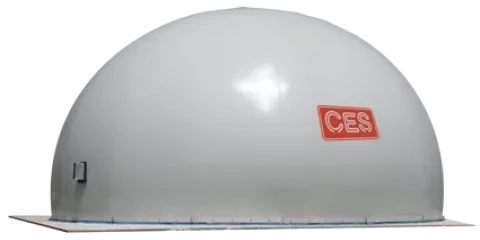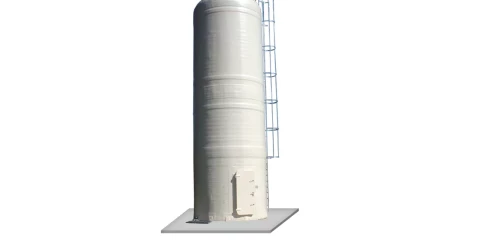History of sewage treatment plant biogas
Although the potential for biogas production in Poland remains largely untapped, as it turns out, the very idea to start using the energy contained in biogas for energy purposes was already present at the beginning of the last century. German engineer Karl Imfoff was involved in a project to build Europe's first prototype experimental sewage treatment plant, the 'Kläranlage Saspe'. The project was carried out in Gdansk in the 1930s, then after the war the facility took the name "Zaspa WWTP". In archive materials we can find drawings confirming the use of biogas-fired gas boilers for heat production. It is likely that there were concepts of generating electricity from biogas already then, as generators were also found on the drawings.
Drawing from 1931 - 1933, boiler house and gas boiler, fired by biogas. Source: http://blizejzrodel.pl/blizej-wiedzy/oczyszczalnia-zaspa-na-wskros-nowoczesna/
Experiments with biogas were interrupted by the Second World War and by the development of coal-based energy. The current shift towards renewable energy sources and worldwide technological advances have allowed the concept of biogas energy utilisation to be revived. Today, biogas recovery technology is widely used in wastewater treatment plants around the world and in Poland.
Cogeneration - a breakthrough in the development of biogas sector
Since the invention of the biogas production method, its general principle has remained the same, but improvements are constantly being made to make the use of biogas as efficient and safe as possible. Developments in technology have made the idea of producing electricity from biogas a reality. This was a breakthrough in the use of biogas. Everyone is aware that combined heat and power production is currently the most efficient way of using biogas. Centrum Elektroniki Stosownej was one of the first Polish companies to introduce cogeneration equipment to the Polish market. Our cogeneration units have been in operation at many wastewater treatment plants, some for 20 years.
Use of biogas plant equipment for even more efficient use of biogas
The biogas produced consists mainly of methane and carbon dioxide and to a lesser extent: oxygen, nitrogen, hydrogen sulphide and siloxanes. Before feeding the CHP unit, the fuel must be brought up to the parameters required by the CHP unit manufacturer (MWM production units: siloxanes < 20mg / 10kWh; hydrogen sulphide < 1,500 ppm/10kWh). Taking care of fuel quality is important from an economic point of view. The better the quality of the biogas, the lower the likelihood of serious and costly breakdowns and the lower the frequency of servicing. This is why it is so important to take care of biogas quality and its proper preparation. This is why, with the development of the CHP market, CES has introduced biogas line equipment into its portfolio.
Siloxane monitor
In biogas, particularly undesirable substances are siloxanes - organosiloxanes that can combine with oxygen or other compounds during the combustion process, which can result in the precipitation of silica and silicates that are deposited on cylinder heads, pistons, turbine blades and heat exchanger surfaces. The siloxane monitor is a simple, compact device that monitors siloxane levels online and provides data in an easy-to-read form of tables and graphs. This allows the level of siloxane concentration in the biogas to be monitored in real time over any length of time. This makes it possible to observe under which conditions siloxane levels in biogas are rising and to react in real time.
The data from the siloxane monitor allows you to know precisely when to replace the activated carbon in the biogas filters. This makes it possible to maximise the use of purchased activated carbon, maintaining safe biogas parameters.
Activated carbon filters
They are used to remove contaminants that can lead to damage to the CHP unit. Activated carbon is used to absorb siloxanes or hydrogen sulphide. The carbon is selected on the basis of the actual composition of the biogas, the concentration of contaminants and the type of substance to be removed. The choice of filter size is dictated by the flow rate and amount of contaminants, as well as the approximate bed replacement time. CES offers filters of optimum design, which are easy to operate and allow the plant to run smoothly without high pressure losses.
Activated carbon bed filters supplied for a biogas plant in Darzyno.
Biogas analysers
They are used to monitor the composition of the biogas. This is a very important part of controlling the quality of the biogas as well as the operation of the entire biogas plant. Most commonly, the concentration of methane, oxygen and hydrogen sulphide is tested. Methane, determines the calorific value of the biogas, which affects the amount of energy produced. High concentrations of hydrogen sulphide can lead to corrosion. Too much oxygen, on the other hand, damages the methane-producing bacteria and creates an explosion hazard. The analysers offer the possibility to control such parameters and react quickly to rectify abnormalities. The analysers are built in a modular way, so it is possible to expand with, for example, additional heads, allowing the concentration of other gases to be tested depending on the customer's needs.
Biogas analyzer - IMC integrated measurement system.
Biological desulphurisation plant
A column filled with a bed in which sulphur bacteria(Thiobacillus) multiply. The bacteria only need the right amount of oxygen, the right temperature and an artificial fertiliser to carry out the process properly. The process of decomposition of H2S by bacteria can be represented by the following equation:
H₂S + 2O₂ = H₂SO₄
2H₂S + O₂ = 2S + 2H₂O
S + H₂O + 1,5O₂ = H₂SO₄
The easy-to-operate plants are capable of treating biogas where the hydrogen sulfide content is as high as 20,000ppm with 95% efficiency! The operation of the biosulfur desulfurization plant is automated, requiring no maintenance beyond simple servicing. Hydrogen sulfide is converted into elemental sulfur and sulfuric acid, this sludge in the case of treatment plants can be returned to the process of aeration of wastewater.
Biogas tanks
These are low-pressure storage facilities that also act as a buffer against equipment that uses biogas as fuel, such as CHP. They are most often made as independent, free-standing objects set on a concrete foundation. The tanks come in 1/2 and 2/3 sphere shapes. They consist of two separate chambers: an air chamber and a gas chamber. The gas chamber is covered by the air chamber. The air chamber is pressurised and ventilated by a blower. The diaphragms are made of durable material, polyester fibre fabric, double-coated with PVC, resistant to UV rays, microbiological effects and abrasion.
Implementation of the construction of a 2640 m3 biogas tank - parallel operation with the existing tank.
Biogas dryers/coolers
Biogas always contains water vapour, condensing inside equipment or in pipelines. Water together with the aggressive chemical compounds contained in biogas can lead to significant corrosion damage. For this reason, we use biogas drying equipment in biogas plants. Biogas drying is carried out according to the condensation drying principle and takes place by cooling the working medium in a shell-and-tube heat exchanger. The cooling of the gas stream causes the water contained in it to condense, allowing it to be removed from the gas; this is done via a condensate trap or condensate tank, equipped with a pump to drain the liquid. The cooled biogas should then be reheated to reduce the relative humidity. As in the previously discussed cases (hydrogen sulphide, siloxanes), humidity is an important parameter for the correct operation of cogeneration equipment (MWM production units: relative humidity < 80%).
Biogas dryer - biogas plant in Darzyno.
Torches
In the event of overproduction or failure of the biogas plant, excess biogas is produced. When there is no biogas reservoir or when the reservoir is completely filled, the excess biogas must be burned. For this purpose, flares are used, which have been designed to operate maintenance-free, low-emission and safely. Emission of biogas directly into the atmosphere, without incineration or any other form of disposal, is not permitted under current legislation and constitutes environmental contamination.
Supply of methane flares to the Anwil S.A.
Biogas blowers
The fuel fed to the CHP units must be at the correct pressure. For this purpose, centrifugal blowers (fans) or side channel blowers are most commonly used on biogas plants. They increase the pressure of the biogas by creating a series of vortices due to the centrifugal thrust - created through the impeller. During compression, the temperature of the biogas rises, which can be further exploited in the drying process. By placing a blower in the process line immediately after the biogas has cooled, it raises the temperature by reducing the relative humidity.
Selection and operation of biogas line equipment
An extremely important aspect is the choice of equipment and the ability to perform regular servicing as recommended by manufacturers. It is worth bearing this in mind when choosing a supplier, as not all companies provide after-sales services. The selection of the equipment should be made by a qualified person with experience, who will approach the subject individually, conduct an interview and take the required parameters from the customer. After the installation of the biogas plant equipment, a service technician is required to come and adjust the equipment and ensure that everything has been installed correctly. We provide a comprehensive service from design through to selection, delivery, installation and commissioning of biogas plants. Please do not hesitate to contact us if you need to use our products in your applications or projects.
Author:
Karol Wyrzykowski
Biogas line equipment
tel.: +48 12/261 05 75
mob.: +48 887 337 223
e-mail: kwyrzykowski@ces.com.pl



